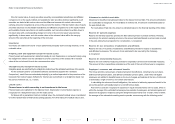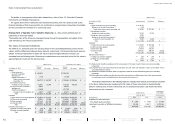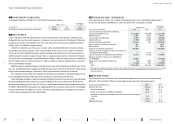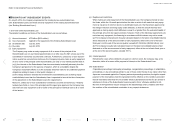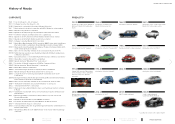Mazda 2016 Annual Report Download - page 65
Download and view the complete annual report
Please find page 65 of the 2016 Mazda annual report below. You can navigate through the pages in the report by either clicking on the pages listed below, or by using the keyword search tool below to find specific information within the annual report.
Derivative transactions are conducted in compliance with internal control rules and procedures
that prescribe transaction authority. The policies for derivative transactions of the Group are
approved by the Company’s President or Financial Officer. Transactions are approved in advance
by either the Company’s Financial Services Division General Manager or Treasury Department
General Manager. Based on these approvals, the Treasury Department conducts and books the
transactions as well as confirms the balance between the counterparty of the derivatives contract.
The operation of the transaction is segregated from its clerical administration, in order to
maintain internal check within the Treasury Department, and is audited periodically by the Global
Auditing Department. Derivative transactions are reported, upon execution, to the Company’s
Financial Officer, Financial Services Division General Manager, and Treasury Department General
Manager. The consolidated subsidiaries also follow internal control rules and procedures pursuant
to those of the Company, obtain approval of the Company, and conduct and manage the transactions
according to the approval.
The following summarizes hedging derivative financial instruments used by the Group and
items hedged:
Hedging instruments: Hedged items:
Forward foreign exchange contracts Foreign currency-denominated
transactions planned in the future
Interest rate swap contracts Interest on borrowings
The following tables summarize fair value information as of March 31, 2016 and 2015 of derivative
transactions for which hedge accounting has not been applied:
Millions of yen Thousands of U.S. dollars
As of March 31, 2016
Contract
amount
Estimated
fair value
Valuation
gain (loss)
Contract
amount
Estimated
fair value
Valuation
gain (loss)
Forward foreign
exchange contracts:
Sell:
U.S. dollar ¥18,579 ¥ 615 ¥ 615 $164,416 $ 5,442 $ 5,442
Euro 1,275 4 4 11,283 36 36
Canadian dollar 7,409 (105) (105) 65,567 (929) (929)
Australian dollar 15,901 (381) (381) 140,717 (3,372) (3,372)
Sterling pound 1,722 112 112 15,239 991 991
Buy:
Thai baht 6,944 (280) (280) 61,451 (2,478) (2,478)
Total ¥51,830 ¥ (35) ¥ (35) $458,673 $ (310) $ (310)
Millions of yen
As of March 31, 2015
Contract
amount
Estimated
fair value
Valuation
gain (loss)
Forward foreign
exchange contracts:
Sell:
U.S. dollar
¥ 4,205 ¥ 4 ¥ 4
Euro
2,016 62 62
Canadian dollar
5,663 (21) (21)
Australian dollar
9,702 51 51
Sterling pound
727 16 16
Buy:
Thai baht
4,099 157 157
Total
¥26,412 ¥269 ¥269
For forward foreign exchange contracts, fair values at year-end are estimated based on prevailing
forward exchange rates at that date.
Notes to Consolidated Financial Statements
MAZDA ANNUAL REPORT 2016
Financial Section
Message from
Management
Review of Operations
Drivers of Value Creation
Foundations Underpinning
Sustainable Growth
Contents


